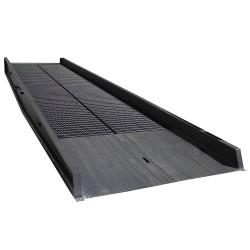We use cookies to make your experience better. To comply with the new e-Privacy directive, we need to ask for your consent to set the cookies. Learn more.
Installing Ramps With Built-In Safety Features to Prevent Serious Accidents

The experiment turned tragic when the idle truck’s wheels turned suddenly, leading the lift truck off the edge of the ramp. The driver was hospitalized with multiple broken bones and lacerations.
This employee was luckier than some. Between 2013 and 2014, the Bureau of Labor Statistics tracked a 10 percent increase in fatal injuries due to falls, slips, and trips, mostly due to an increase in falls to a lower level — a significant cause of loading dock fatalities.
Safety training will help reduce the chance of injury on loading docks, but smarter equipment design also has an important role to play. If the truck ramp in the above example had been lined with tall, durable curbs, the employee might have had time to rethink the unloading plan without suffering a devastating injury.
Look for the following safety features in the dock ramps and truck ramps at your facility. If you don’t see them, it may be time to consider updating your loading dock infrastructure:
-
High-Traction Surfaces.
Loading docks are high-traffic areas that are exposed to the elements, and it’s not uncommon for work surfaces to collect a film of oily dirt. While this is unsafe on any surface, it can be deadly for forklift operators on a grade.
BHS Dock Ramps and Yard Ramps incorporate an open steel grating to reduce moisture build up and provide superior traction for forklift wheels. Make sure your forklift ramps offer the traction forklifts need to safely carry loads in either direction.
-
Low-Angle Slope.
Inclines create a greater risk of losing loads or tipping forklifts. Reduce these hazards by installing a longer ramp, which creates a shallower grade. BHS Yard Ramps, for instance, transition gradually from the ground to truck beds with a 36 foot pathway of powder-coated steel.
-
Tall and Tough Curbs.
OSHA instructs forklift operators to “keep a safe distance from the edge of a ramp.” Add an additional level of protection with high steel barriers along truck and dock ramps.
BHS Dock Ramps and Yard Ramps feature 8 inch steel curbs along the entire travel path. This height is sufficient to stop forklifts even if the driver misjudges the edge.
-
Dependable Means of Securing at Ground and Dock Level.
Many loading injuries occur when ramps or dock plates shift under forklift drive wheels. Yard ramps should be secured to trucks with safety chains, and dock ramps must be anchored to the surface of the dock and at ground level. BHS Dock Ramps double the anchors at ground level to prevent the risk of slipping.
According to occupational safety journal EHS Today, a full quarter of injury-causing accidents occur at loading docks. How many of those injuries could have been prevented with safer travel surfaces? If every dock ramp in the country had high curbs, low angles, and a high-traction surface, the Bureau of Labor Statistics might have better statistics to promote.
References:
“Accident Report Detail - 202556130 - Employee Suffers Injuries in Forklift Accident.” OSHA. Occupational Safety & Health Administration, United States Department of Labor, 28 Jan. 2013. Web. 17 Sept. 2015.
Brittingham, Michael “A Dry Dock Is a Safe Dock.” EHSToday. Penton, 1 Oct. 2010. Web. 17 Sept. 2015.
“Economic News Release: Census of Fatal Occupational Injuries Summary, 2014.” BLS. Bureau of Labor Statistics, United States Department of Labor, 17 Sept. 2015. Web. 17 Sept. 2015.
“Powered Industrial Trucks (Forklift) - Understanding the Workplace: Ramps and Grades.” OSHA. Occupational Safety & Health Administration, United States Department of Labor, n.d. Web. 17 Sept 2015.
